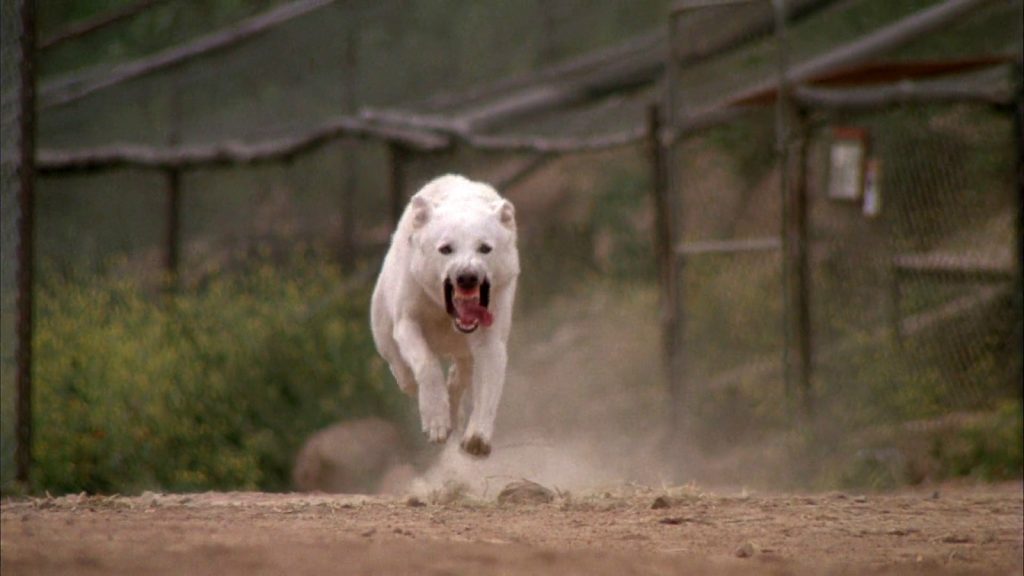
White Dog follows Judy, a struggling actress who hits a white dog with her car. When she is unable to find the owner, Judy adopts the animal, which in turn saves her from being raped by a home intruder. Shortly thereafter, the dog attacks a friend of Judy’s. Assuming the dog is trained to attack, Judy seeks out the aid of professional animal trainers Carruthers (Burl Ives) and Keys (Paul Winfield). It isn’t long before they discover that the dog is a “white dog” (trained by a racist to kill people of color), and Keys becomes obsessed with “curing” the animal.
Samuel Fuller had long grappled with the problems of racism over the course of a long career in film (addressing this issue explicitly for the first time in 1951’s The Steel Helmet) when, in 1981, the issue of racism would finally be at the forefront of one of his films in White Dog. The character of Keys (Paul Winfield) says in the film that a dog “only sees black and white”. Keys’ observation is a summation of the political perceptions adopted by both himself, Judy (Kristy McNichol) and most audiences, then and now. As White Dog progresses, the political views of the characters become more black and white. It’s a recurring motif in the films of Samuel Fuller that the journey of a character(s) hardens their view, distilling all the complications and contexts into one simple “yes or no” question that they must answer. The Big Red One (1980) follows an entire outfit of soldiers as their view of morality and justice is systematically simplified over the course of the narrative. Fuller is aware that audiences see these moral dilemmas in much simpler terms than say the government, and that distilling these concepts is a means by which to help the audience understand the conflicts in his films. Yet it seems Fuller is also aware that such a simplified perceptions makes it much easier for both his characters and people in general to make tough decisions, to play the parts of hero and villain.
Though the views and behavior of the human characters are manifest in the black and white vernacular of pulp, the “white dog” is a consistently complex symbol (beyond being a “white dog” with white fur). From the outset of the film the dog is the most sympathetic character; he’s man’s best friend. As the dog shows more and more signs of his penchant for racially motivated violence, it remains inherently impossible to hate the dog. Fuller reenforces the audiences’ affiliation with the dog by giving the dog as much to do and as much screen time to do it as he does the film’s cast. Within the film, the dog becomes as much a fully realized character as his human counterparts, a rare feat outside of a children’s film. Where most films suffer when a character’s racism prevents the audience from sympathizing with them Fuller avoids this problem altogether, instead employing this sympathy to better convey the nature of racism as a byproduct of learning or perhaps upbringing. No one wants to believe a dog is born racist any more than they don’t want to see the dog cured. And when the dog can’t be cured, one feels as much for the dog as they do for Burl Ives, who the dog attacks.
White Dog also brings up an issue by treating racism as a disease. Throughout the film, Keys claims, “I’ll cure that dog”. The implications of this line are that racism can be cured and that racism is a disease. The relationship between cause and symptoms, if we assume for a minute racism is a disease transmitted through behavior, it seems equitable with a disease such as anorexia. If that is so, racism is a behavioral disease stemming from societal pressures manifest by the parents taking on similar forms of the disease’s symptoms. This could arguably be substantiated by Fuller’s film. Regardless of Fuller’s definite intention, the film suggests this as a clear possibility and to not consider it would negligence.
